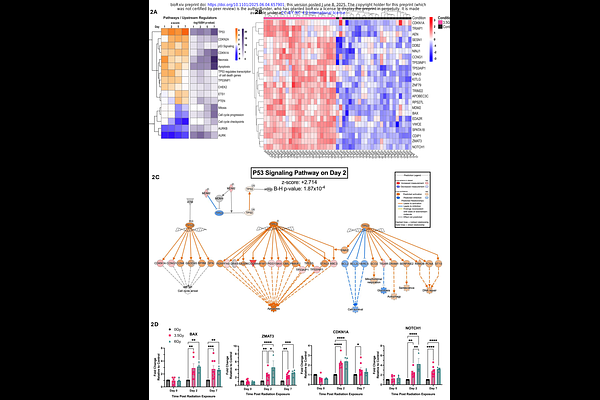A human ex vivo model of radiation-induced skin injury reveals p53-driven DNA damage signaling and recapitulates a TGFβ fibrotic response

A human ex vivo model of radiation-induced skin injury reveals p53-driven DNA damage signaling and recapitulates a TGFβ fibrotic response
Dodson, C.; Bilik, S. M.; DiBartolomeo, G.; Pachalis, H.; Siegfried, L.; Johnson, J. A. K.; Thaller, S. R.; Pastar, I.; Tomic-Canic, M.; Griswold, A. J.; Stone, R. C.
AbstractRadiation-induced skin injury is a poorly understood complication affecting cancer patients who undergo radiotherapy, with no current therapies able to prevent or halt its progression to debilitating radiation-induced skin fibrosis (RISF). Addressing the need for clinically relevant human models, this study developed and characterized a human ex vivo skin model that recapitulates the temporal molecular processes of cutaneous radiation injury, as demonstrated through bulk RNA-sequencing and tissue validation studies. Human skin explants subjected to ionizing radiation demonstrated rapid induction of DNA double-strand breaks, followed by a robust, p53-driven transcriptional program involving genes related to cell cycle arrest, apoptosis, and senescence. Over time, the irradiated skin exhibited increasing activation of pro-fibrotic pathways, notably epithelial-mesenchymal transition and TGF{beta}1-mediated signaling. This resulted in upregulation of classic fibrosis markers such as COL1A1, FN1, and increased collagen thickness. Importantly, regulators of the p53 axis, MDM2 and miR-34a, was observed, implicating these factors as potential therapeutic targets to modulate the balance between repair of radiation injury and pathologic fibrosis. Transcriptome analysis of irradiated and non-irradiated breast skin from post-mastectomy patients showed notable concordance of p53 and pro-fibrotic gene signatures comparable to the ex vivo model, underscoring its translational relevance. This work provides a platform for identifying early biomarkers and testing therapeutic strategies to prevent or mitigate cutaneous radiation toxicities, including RISF, beginning with elucidating the dynamic interplay between the p53-mediated DNA damage response and the onset of fibrosis following radiation. Ultimately, this work aims to improve long-term skin health and quality of life for cancer patients.